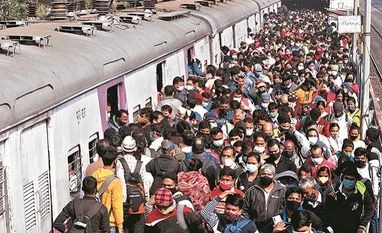The 2022 version of United Nations World Population Prospects was released during the second week of July. It said the world population will breach the eight billion mark on November 15 this year.
And India will overtake China next year to become the world’s most populous nation with over 1.4 billion people. In 2050, the country is projected to have a population of 1.66 billion - way ahead of China’s 1.31 billion.
This might be not only because the rate of population growth in India is higher than in China, but the neighbour is also expected to experience an absolute decline in its population as early as next year.
This increasing population will put additional pressure on resources, which are already stretched. Changes in a country’s population size are always a result of the demographic transitions. One such phase is where the growth of the working age population -- aged 15-64 years -- is temporarily higher than the combined shares at younger and older ages.
This presents an opportunity for accelerated economic growth and social development, known as the ‘demographic dividend’.
In 2020, there were about 900 million Indians, which amounts to 67% of total population, in the working age group as compared to China’s 64.9%.
The UN population report mentions that the working-age group will continue to increase for some time in Asia.
Madan Sabnavis, Chief Economist, Bank of Baroda, says news about population growth prima facie appears to be good as India will have a larger labour force. It will be a challenge to make sure the population is well-educated and make the labour force contribute to GDP, and there is a need to create viable jobs in the knowledge economy.
India barely invests 1.29% of the GDP annually on health, which is less than Bangladesh and Nepal. In contrast, China spends 6.7% of its GDP on health. Meanwhile, India’s education spending at around 3 to 3.5% of GDP is way below the global average of 4.2% or say Brazil’s 6.3% of GDP.
Coming to the job creation, if India does not create enough jobs and its workers are not adequately prepared for those jobs, then the demographic dividend may turn into a liability. Currently, the labour force participation rate, which is the proportion of the working-class willing to work, is lower in India at 46% than China’s 68%, according to a World Bank database.
This is because of the low female labour force participation rate in India, which is around 19%, compared with China’s 62%.
In August 2020, a McKinsey Global Institute report had said that India needed to generate 90 million non-farm jobs between 2023 and 2030 in order to absorb new workers and an additional 30 million workers who could shift from farm work to non-farm sectors.
‘To absorb this influx, India would need close to 12 million additional gainful non-farm jobs every year starting in financial year 2023. This would be triple of the four million non-farm jobs created annually between 2012 and 2018’, the report noted.
To create jobs at such a massive scale, India’s GDP will need to grow by 8 to 8.5% annually over the next decade and the productivity growth needs to be maintained at 6.5 to 7%.
Moving on, should we be alarmed by the rate of population growth in general? Not so much. India’s total fertility rate -- the average number of children that could be born to a woman in her lifetime – has declined from 2.2 in 2015-16 to 2 in 2019-21.
Institute of Health Metrics and Evaluation projects the country’s total fertility rate at 1.29 births per woman by the end of the century. This is way below the UN’s replacement level fertility rate at 2.1 children per woman.
The latest NFHS survey also shows over two-thirds of Indian states have below replacement level fertility rates. Below-replacement fertility rates eventually result in negative population growth.
While India is expected to have a demographic dividend, reaping its potential benefits requires significant investments in education and health, and work towards the availability of gainful employment. This is a challenge not only for the government, but also for the private sector.
)